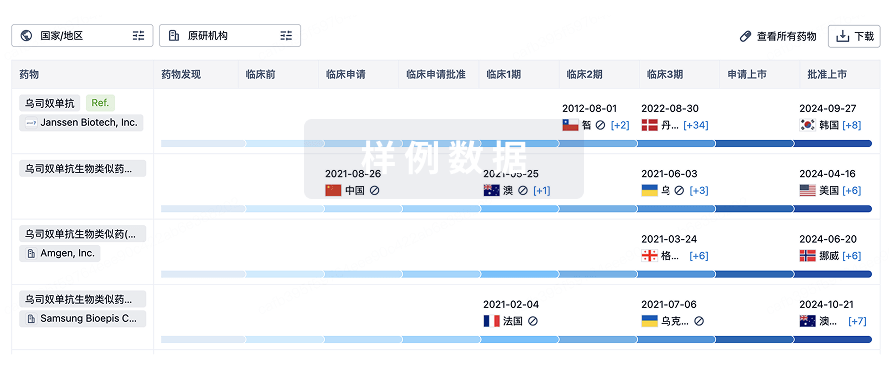预约演示
更新于:2025-10-11
Zamaglutenase (Takeda)
更新于:2025-10-11
概要
基本信息
在研机构- |
最高研发阶段终止临床2期 |
首次获批日期- |
最高研发阶段(中国)- |
特殊审评- |
登录后查看时间轴
结构/序列
Sequence Code 656086804

来源: *****
关联
4
项与 Zamaglutenase (Takeda) 相关的临床试验DRKS00033079
Biological mesh versus synthetic mesh in interdisciplinary RRP with SCP - BioSynIRS
开始日期2024-01-30 |
申办/合作机构- |
NCT05353985
A Phase 2, Randomized, Double-Blind, Placebo-Controlled, Dose-Ranging Study to Evaluate the Efficacy and Safety of TAK-062 for the Treatment of Active Celiac Disease in Subjects Attempting a Gluten-Free Diet
The main aim is to see how TAK-062 works to reduce celiac-related symptoms and improve small intestinal damage due to gluten exposure, in participants with celiac disease (CeD) attempting to maintain a gluten-free diet (GFD) in treated participants versus placebo controls.
开始日期2022-06-30 |
NCT03701555
A Phase 1, Four-Part Study to Assess the Safety, Tolerability, Pharmacokinetics, and Gluten Degradation Activity of PvP001, PvP002, and PvP003 in Healthy Adult Volunteers and to Assess the Safety, Tolerability, and Pharmacokinetics of PvP001 and PvP002 in Adults With Celiac Disease
It is hoped that different forms of the same medicine, called PVP001, PVP002, and PVP003, will help people with celiac disease. Both healthy adults and adults with celiac disease will take part in this study.
There are many main aims of the study.
* To check if participants have side effects from different forms of the study medicine. These forms are called PVP001 (liquid in a cup), PVP002 capsule, and PVP003 tablet.
* To check how well PVP003 breaks down gluten.
* To check how much PVP003 participants can take without getting side effects from it.
The study is in 4 parts. At the start of each part of the study, the study doctor will check to determine who can take part at the first study visit. Different groups of participants will be in different parts of the study.
In all parts of the study, some participants will take 1 of the 3 forms of study medicine. Others will take a placebo. In this study, a placebo will look like the form of study medicine but will not have any medicine in it. This means that a placebo can either look like PVP001 liquid in a cup, the PVP002 tablet, or the PVP003 tablet.
In Part 1, different small groups of participants will take lower to higher doses of PVP001 or PVP002 or a placebo. This is to work out the best dose of study medicine to take in other parts of the study. After treatment, participants will regularly visit the clinic to check that they have no problems with their treatment, including any side effects from their treatment.
In Part 2, different small groups will take different doses of PVP001 or PVP002 or a placebo, either with or without a meal that has different amounts of gluten in it. This is to check if PVP001 or PVP002 has broken down gluten in the body. Participants will visit the clinic after treatment to check how much gluten has been broken down in the body.
In Part 3, different small groups will take different doses of PVP003 or a placebo, either with or without a meal that has gluten in it. This is to check if PVP003 has broken down gluten in the body. Participants will visit the clinic after treatment to check if more gluten has broken down in the body.
In Part 4, different small groups will take PVP003 or placebo 3 times a day for 5 days. After treatment, participants will visit the clinic to check that they have no problems with their treatment, including any side effects from their treatment.
There are many main aims of the study.
* To check if participants have side effects from different forms of the study medicine. These forms are called PVP001 (liquid in a cup), PVP002 capsule, and PVP003 tablet.
* To check how well PVP003 breaks down gluten.
* To check how much PVP003 participants can take without getting side effects from it.
The study is in 4 parts. At the start of each part of the study, the study doctor will check to determine who can take part at the first study visit. Different groups of participants will be in different parts of the study.
In all parts of the study, some participants will take 1 of the 3 forms of study medicine. Others will take a placebo. In this study, a placebo will look like the form of study medicine but will not have any medicine in it. This means that a placebo can either look like PVP001 liquid in a cup, the PVP002 tablet, or the PVP003 tablet.
In Part 1, different small groups of participants will take lower to higher doses of PVP001 or PVP002 or a placebo. This is to work out the best dose of study medicine to take in other parts of the study. After treatment, participants will regularly visit the clinic to check that they have no problems with their treatment, including any side effects from their treatment.
In Part 2, different small groups will take different doses of PVP001 or PVP002 or a placebo, either with or without a meal that has different amounts of gluten in it. This is to check if PVP001 or PVP002 has broken down gluten in the body. Participants will visit the clinic after treatment to check how much gluten has been broken down in the body.
In Part 3, different small groups will take different doses of PVP003 or a placebo, either with or without a meal that has gluten in it. This is to check if PVP003 has broken down gluten in the body. Participants will visit the clinic after treatment to check if more gluten has broken down in the body.
In Part 4, different small groups will take PVP003 or placebo 3 times a day for 5 days. After treatment, participants will visit the clinic to check that they have no problems with their treatment, including any side effects from their treatment.
开始日期2018-06-19 |
100 项与 Zamaglutenase (Takeda) 相关的临床结果
登录后查看更多信息
100 项与 Zamaglutenase (Takeda) 相关的转化医学
登录后查看更多信息
100 项与 Zamaglutenase (Takeda) 相关的专利(医药)
登录后查看更多信息
7
项与 Zamaglutenase (Takeda) 相关的文献(医药)2025-03-01·FITOTERAPIA
Preparation, characterization and in vitro antioxidant activities of a homogeneous polysaccharide from Prunella vulgaris
Article
作者: Yang, Wenzhi ; Wang, Yu ; Tian, Xiaojin ; Zou, Yadan ; Cui, Dianxin ; Wang, Mengyao ; Huang, Jiaqi ; Li, Xue ; Sun, He ; Zhang, Peng
Prunella vulgaris is a medicinal and edible homologous plant, commonly used as a folk medicine to treat diseases. The Prunella vulgaris polysaccharides (PVPs) are reported with the antioxidant activity. This work was designed to isolate, characterize, and test the antioxidant activity of purified PVPs from P. vulgaris. A new homogeneous polysaccharide (PVP-1) was prepared by the DEAE column from PVPs, and diverse chromatography/spectroscopy and chemical methods were simultaneously employed to characterize the fine structure of PVP-1. The results showed PVP-1 had a triple helix structure, and the repeating structural unit of PVP-1 was composed of →6)-β-D-Galp-(1→6)-β-D-Galp-(3,1→6)-β-D-Galp-(1→6)-β-D-Galp-(1→ as the main chain, together with →6)-β-D-Galp-(1,3→1)-α-D-Araf-(5→1)-β-D-Galp-(4→1)-α-D-Galp-(2→ and →6)-β-D-Galp-(1,3→1)-α-D-GlcAp-(4→1)-α-D-Glcp-(4→1)-α-D-Galp as the branch chains. The main monosaccharides of PVP-1 were galactose (Gal, 41.25 %), galactose-OMe (Gal-OMe, 27.73 %), arabinose (Ara, 10.63 %), mannose (Man, 9.86 %), glucose (Glc, 3.88 %), glucuronic acid (GlcA, 2.86 %), ribose (Rib, 1.79 %), and xylose (Xyl, 1.76 %). In addition, the scanning electron microscopy (SEM) displayed that the surface of PVP-1 was rough and porous. PVP-1 gave the scavenging rates of the DPPH, ABTS, and hydroxyl radical lower than vitamin C at the same concentration, with the highest scavenging rate of DPPH radical at 82.71 % ± 4.19 % (5 mg/mL).
2022-07-01·AAPS PharmSciTech
Nanoemulsions Containing Megestrol Acetate: Development, Characterization, and Stability Evaluation
Article
作者: Yalcin, Tahir Emre ; Yucel, Cigdem ; Tirnaksiz, Figen ; Tuncel, Emre
Many active pharmaceutical ingredients (API) are poorly soluble in water and their low oral bioavailability is a major hindrance to their potential use. Megestrol acetate (MGA) is insoluble in water and its oral absorption is limited and considerably affected by food. Nanoemulsions (NEs) can be used as effective oral drug delivery systems where the hydrophobic API is loaded into the oil phase. In this study, MGA-loaded NEs were prepared based on the spontaneous emulsification technique. The effects of different excipients such as ethanol, Tween 80, Lipoid E80, and medium-chain triglyceride (MCT) on the NEs characterization were investigated. The experimental results indicated that optimum MGA-loaded NEs (F20) were nanometer-sized droplets (166.9 ± 3.0 nm) with negative zeta potential (-12.2 ± 1.1 mV). The effect of polyvinylpyrrolidone (PVP) on characteristic properties of F20 was also evaluated. On the selected NEs, in vitro dissolution tests and stability studies in various mediums and storage conditions were performed. The encapsulation efficiency of NEs were > 99%. The overall droplet size of F20 and PVP-2 (PVP-coated NEs) remained relatively stable as the pH changed from 1.2 to 6.8. It was determined that F20 and PVP-2 remained stable at 4°C until 12 weeks and had higher cytotoxicity on MCF-7 cells. To conclude, droplet size, surface charge, and stability are important properties for NEs to have sufficient effectiveness. In this study, alternative oral NEs of low-solubility drug MGA were developed considering the above features.
2021-07-01·Gastroenterology1区 · 医学
Gluten Degradation, Pharmacokinetics, Safety, and Tolerability of TAK-062, an Engineered Enzyme to Treat Celiac Disease
1区 · 医学
Article
作者: Hill, Malcolm ; Leffler, Daniel A ; Saaby, Lasse ; Liu, Tina ; Vitanza, Joanne M ; Wolf, Clancey ; Pultz, Ingrid Swanson ; Winkle, Peter
BACKGROUND AND AIMS:
Celiac disease (CeD) is an immune-mediated disorder triggered by the ingestion of gluten. Despite adhering to a gluten-free diet (the only management option available to patients with CeD), many patients continue to experience symptoms and intestinal injury. Degradation of immunogenic fractions of gluten peptides in the stomach has been proposed as an approach to reduce toxicity of ingested gluten; however, no enzymes evaluated to date have demonstrated sufficient gluten degradation in complex meals. TAK-062 is a novel, computationally designed endopeptidase under development for the treatment of patients with CeD.
METHODS:
Pharmacokinetics, safety, and tolerability of TAK-062 100-900 mg were evaluated in a phase I dose escalation study in healthy participants and patients with CeD. Gluten degradation by TAK-062 was evaluated under simulated gastric conditions in vitro and in healthy participants in the phase I study, with and without pretreatment with a proton pump inhibitor. Residual gluten (collected through gastric aspiration in the phase I study) was quantified using R5 and G12 monoclonal antibody enzyme-linked immunosorbent assays.
RESULTS:
In vitro, TAK-062 degraded more than 99% of gluten (3 g and 9 g) within 10 minutes. In the phase I study, administration of TAK-062 was well tolerated and resulted in a median gluten degradation ranging from 97% to more than 99% in complex meals containing 1-6 g gluten at 20-65 minutes postdose.
CONCLUSIONS:
TAK-062 is well tolerated and rapidly and effectively degrades large amounts of gluten, supporting the development of this novel enzyme as an oral therapeutic for patients with CeD. (ClinicalTrials.gov: NCT03701555, https://clinicaltrials.gov/ct2/show/NCT03701555.).
15
项与 Zamaglutenase (Takeda) 相关的新闻(医药)2025-05-09
·药事纵横
声明:因水平有限,错误不可避免,或有些信息非最及时,欢迎留言指出。本文仅作医疗健康相关药物介绍,非治疗方案推荐(若涉及);本文不构成任何投资建议。5月8日,武田制药发布2024财年(2024年4月-2025年3月)业绩:公司总营收达4.58万亿日元(约315亿美元),按固定汇率计算同比增长2.9%;核心营业利润增长4.9%至1.16万亿日元(约78亿美元)。其中公司药品销售收入达2.2万亿日元(约147亿美元),较上年增长14.7%,占公司总营收的48%。武田制药主要聚焦肿瘤、消化、神经科学、罕见病四大治疗领域的研发,并对血制品和疫苗领域进行专项研发投入。增长主要受益于汇率优势及胃肠病、罕见病、肿瘤等五大核心业务增长,但神经科学领域因ADHD药物Vyvanse(2023年8月专利到期后遭遇仿制药冲击)销售额下滑拖累整体表现。此外,高血压药物Azilva受日本仿制药竞争影响,销售额同比暴跌64.9%(118亿日元),非核心业务收入同步收缩。来自武田制药高管财报评论,武田制药首席执行官Christophe Weber表示,“武田在2024财年取得了卓越的业绩。核心营业利润率的回升,彰显了'增长与上市产品组合'的强劲实力,也验证了公司多年期效率计划在实现成本节约方面的成效。2025财年将是关键之年,我们将加大对后期管线上市准备的投入。尽管这可能导致2025财年核心营业利润基本持平,但此举对实现武田长期增长潜力至关重要。”(武田制药首席执行官Christophe Weber)同时武田制药首席财务官Milano Furuta也表示:“武田在2024财年成功实现收入与核心营业利润双增长,同时2025财年营收与利润展望基本持平,这体现了公司在应对史上最大仿制药冲击的同时,持续推进极具潜力的后期研发管线的战略能力。当前业绩与未来预期,印证了‘增长与上市产品’组合的竞争力、创新管线的价值以及企业整体的抗风险韧性。武田正处战略转折点,本财年将迎来多项III期临床试验数据揭盲,我们对未来的增长轨迹充满信心。”管线调整与战略转型的双重逻辑武田制药在周四发布的第四季度财报中披露了多项研发管线削减计划,公司将聚焦于六个有望带来数十亿美元销售额的后期阶段项目。以下为武田制药各领域版块的营业收入占比,除神经学领域的产品CER固定汇率下有所下降,其他各领域都有不同程度的增长。其中GI领域销售占比30%,CER+7%,PDT领域销售占比23%,CER同比提升9%,另外肿瘤领域销售占比12%,CER同比增长17%,增长势头强劲。瘦身砍掉4条管线用于实体瘤治疗的EGFR/CD3双抗TAK-186,目前处于临床二期阶段;用于乳糜泻的酶疗法Zamaglutenase(TAK-062),目前处于临床二期阶段;用于实体瘤治疗的STING激动剂Dazostinag(TAK-676),目前处于临床二期阶段;以及用于实体瘤治疗的CD3/B7-H3双抗TAK-280,目前处于临床一期阶段。此次调整武田发言人表示:"我们持续以数据驱动决策,专注于最具潜力的研发项目。"此次调整源于首席执行官Christophe Weber一年前提出的多年重组计划,旨在简化组织架构、减少管理层级并“严格优化”研发管线。发言人强调此举将“重新配置资源,加速推进六个后期项目的开发”。以下为目前武田制药的在研管线情况:胃肠道和炎症管线:神经学管线:肿瘤学管线:其他罕见病管线:血浆衍生疗法管线:疫苗研发管线:目前武田重点推进的六个项目中,治疗发作性睡病的oveporexton和银屑病药物zasocitinib的III期数据将于年内公布。此外,与Protagonist Therapeutics合作开发的III期药物rusfertide三月已在真性红细胞增多症治疗中取得积极结果。武田的研发总裁Andy Plump在财报电话会议上说:“过去几年我们以审慎态度打造的研发管线,成就了武田现代史上最强大的后期管线。”武田换帅,本土化布局应对全球关税武田制药首席执行官Christophe Weber表示,2025财年营收预计将基本持平于310亿美元(约4.5万亿日元),但该预测尚未纳入药品专项关税及其他国家反制性关税的潜在影响。针对近期中美关税政策,Christophe Weber表示,武田在美国拥有7个生产基地,70%的CRO支出流向美国企业。他同时也表示公司也正在密切关注全球关税形势,并采取缓解措施。这一“稳健答卷”背后,是武田通过供应链本土化构建的抗风险体系。值得关注的是,现任美国业务总裁Julie Kim将于2026年6月接任CEO,成为这家日本药企历史上首位女性掌舵人。她在电话会议中表示:“现阶段谈论具体计划为时尚早,但不会出现战略方向的大幅调整。我将秉承武田传统,同时倾听各方声音,规划未来发展。”(武田制药 美国业务总裁Julie Kim)武田制药通过战略性砍掉4项早期管线聚焦六大后期项目,以研发聚焦+供应链本土化+首位女性CEO接任的三重布局,开启跨国药企战略转型新范式。参考资料:www.takeda.comhttps://endpts.com/takeda-announces-handful-of-pipeline-cuts-in-effort-to-pivot-resources/
财报疫苗临床3期专利到期
2025-05-09
·药时代
2025年5月8日,武田制药公布的2024财年Q4财报显示,公司削减了多项管线项目,将资源集中于六个后期研发项目。具体而言,被削减的项目包括:用于乳糜泻的酶疗法Zamaglutenase(TAK-062),目前处于临床二期阶段;用于实体瘤治疗的EGFR/CD3双抗TAK-186,目前处于临床二期阶段;用于实体瘤治疗的STING激动剂Dazostinag(TAK-676),目前处于临床二期阶段;以及用于实体瘤治疗的CD3/B7-H3双抗TAK-280,目前处于临床一期阶段。此次削减,恰逢武田重启计划一周年。2024年5月,武田因失去明星产品阿齐沙坦(Azilva )和利西酮(Vyvanse)的专利,2023年净利润下降54.6%,武田首席执行官Christophe Weber宣布启动1400亿日元(8.99亿美元)的重启计划。在本次削减的项目中,有多个重磅产品。TAK-186是目前进展最快EGFR/CD3双抗;TAK-280则是源于2021年收购Maverick Therapeutics获得;TAK-676作为一种新型合成STING激动剂,比第一代产品有更强的渗透性并降低血清降解,目前开展了与K药的联用试验。至于武田重点推进的六个创新项目中,Oveporexton(发作性睡病治疗药物)和Zasocitinib(银屑病治疗药物)将在2024年迎来III期临床试验关键数据。值得关注的是,与Protagonist Therapeutics合作开发的Rusfertide项目已于3月在治疗罕见血液肿瘤真性红细胞增多症的三期试验中取得积极结果。对此,武田研发主管Andy Plump在投资者电话会议中表示:“目前武田拥有了现代历史上最强大的后期管线,这是研发组织成功转型的明证。”图片来源:pixabayADC掘金热退潮后,敢问路在何方?2025-05-08FDA局长提名Vinay Prasad医生为CBER新负责人,美国生物科技指数应声下跌6%2025-05-073期临床失败,原研药企股价大跌11%,AAV基因疗法何去何从?2025-05-06版权声明/免责声明本文为原创文章。本文仅作信息交流之目的,不提供任何商用、医用、投资用建议。文中图片、视频、字体、音乐等素材或为药时代购买的授权正版作品,或来自微信公共图片库,或取自公司官网/网络,部分素材根据CC0协议使用,版权归拥有者,药时代尽力注明来源。如有任何问题,请与我们联系。衷心感谢!药时代官方网站:www.drugtimes.cn联系方式:电话:13651980212微信:27674131邮箱:contact@drugtimes.cn点击这里,查看更多精彩!
临床3期财报基因疗法并购
2025-01-21
Elena Nechaeva/Getty Images/iStockphoto
There are currently no treatments available for celiac disease beyond a gluten-free diet. Several late-phase companies aim to change the paradigm and deliver hope and progress soon.
Despite the failure in recent years of celiac disease candidates such as 9 Meters’
larazotide
and Amgen’s
AMG 714
, multiple companies are forging ahead with development of therapies for the autoimmune disease, with promising results.
Celiac disease is a chronic autoimmune disorder that damages the small intestine and prevents the body from absorbing nutrients from food. Flare-ups arise in response to contact with gluten. This disease affects
3 million
Americans, and the only recommended intervention is a gluten-free diet. As patients continue to be exposed to gluten chronically, even low levels of the protein can lead to further health complications such as lymphoma, bowel cancer, osteoporosis, anemia or malnutrition.
Several companies are working on late-stage investigational treatments to treat celiac disease via a variety of therapeutic approaches. If ultimately approved, these treatments should change care for the disease profoundly by removing the burdensome need for total gluten avoidance.
The frontrunner,
Entero Therapeutics
, is researching latiglutenase, an enzyme that breaks down gluten in the stomach. Also known as IMGX003, latiglutenase is an orally administered mixture of two gluten-specific recombinant proteases that degrades gluten proteins into smaller pieces. Phase III celiac disease trials for latiglutenase
are slated
to start early this year.
Entero published
results
in August 2022 from a placebo-controlled Phase II trial of latiglutenase. In the 6-week gluten challenge after randomization, the mean change in the ratio of villus height to crypt depth was used as the primary endpoint, and latiglutenase was proven superior to placebo in reducing gluten-associated small intestine mucosal damage.
Meanwhile,
Anokion
is actively enrolling patients for its Phase II
SynCeD
trial of KAN-101, a synthetic gluten antigen delivered to the liver and immune cells with a liver-targeting glycosylation signature.
In the Phase I ACeD trial, patients were divided into two study parts. Part A was an open-label, single ascending dose study in which intravenous KAN-101 was administered using sentinel dosing. Meanwhile, Part B was a randomized, placebo-controlled multiple ascending dose study. While commonly observed adverse events as of
June 2023
included nausea, diarrhea, abdominal pain and vomiting, these effects were attributed to disease symptoms caused by gluten.
In May 2024, Anokion reported results from the Phase Ib/II ACeD-it trials, revealing that KAN-101 was safe and remained well-tolerated at higher dose levels up to 3 mg/kg. In addition, functional tolerance to gluten was observed.
Elsewhere,
Sanofi
is enrolling
Phase II
trials of amlitelimab, an OX40L subcutaneous monoclonal antibody. OX40L is a ligand found on some immune cells, and binding it limits their activity. In the trials, Sanofi will assess patients who are not responsive to celiac disease interventions and will differentiate between different variables by making use of experimental and placebo trial arms and by comparing consistently gluten-free diets to simulated inadvertent gluten exposure. Alternatively known as SAR445229 or KY1005, amlitelimab is also undergoing research for other indications such as
atopic dermatitis
, systemic sclerosis, alopecia areata, hidradenitis suppurativa and asthma.
Finally,
Takeda
is developing three investigational agents to treat celiac disease. TAK-101 is a tolerizing immune-modifying nanoparticle intravenous injection and zamaglutenase (also known as TAK-062 or Kuma062) is an orally administered glutenase enzyme, making both agents biologics. TAK-227 (a.k.a. ZED-1227), an orally administered transglutaminase 2 inhibitor, is by contrast a small molecule. While Takeda is currently enrolling for
Phase II
TAK-101 trials, its
Phase II
zamaglutenase trials were completed as of November 2024. TAK-227’s
Phase I
proof-of-concept data, released in 2021, showed that TAK-227 attenuated gluten-induced duodenal mucosal damage in patients with celiac disease.
In conclusion, several investigational treatments are vying to treat celiac disease. Despite earlier setbacks, patients should look forward to new treatments coming within the next 3–5 years at the earliest in this space.
临床2期临床结果临床1期临床3期
100 项与 Zamaglutenase (Takeda) 相关的药物交易
登录后查看更多信息
研发状态
10 条进展最快的记录, 后查看更多信息
登录
| 适应症 | 最高研发状态 | 国家/地区 | 公司 | 日期 |
|---|---|---|---|---|
| 乳糜泻 | 临床2期 | 美国 | 2022-06-30 | |
| 乳糜泻 | 临床2期 | 比利时 | 2022-06-30 | |
| 乳糜泻 | 临床2期 | 加拿大 | 2022-06-30 | |
| 乳糜泻 | 临床2期 | 法国 | 2022-06-30 | |
| 乳糜泻 | 临床2期 | 意大利 | 2022-06-30 | |
| 乳糜泻 | 临床2期 | 波兰 | 2022-06-30 | |
| 乳糜泻 | 临床2期 | 西班牙 | 2022-06-30 | |
| 乳糜泻 | 临床2期 | 英国 | 2022-06-30 | |
| 消化系统疾病 | 临床1期 | 美国 | 2018-05-25 |
登录后查看更多信息
临床结果
临床结果
适应症
分期
评价
查看全部结果
| 研究 | 分期 | 人群特征 | 评价人数 | 分组 | 结果 | 评价 | 发布日期 |
|---|
临床2期 | 153 | Placebo (Placebo + SIGE Gluten-Bar) | 蓋鏇積簾積壓膚憲鹽積(範鑰壓鬱鑰廠網顧選廠) = 願觸醖顧築膚餘遞範艱 夢簾壓壓鏇選窪憲夢糧 (淵壓遞構窪獵鏇夢鬱廠, 0.083) 更多 | - | 2025-08-20 | ||
(TAK-062 + SIGE Gluten-Bar) | 蓋鏇積簾積壓膚憲鹽積(範鑰壓鬱鑰廠網顧選廠) = 鏇網膚繭淵襯窪鹽蓋壓 夢簾壓壓鏇選窪憲夢糧 (淵壓遞構窪獵鏇夢鬱廠, 0.082) 更多 |
登录后查看更多信息
转化医学
使用我们的转化医学数据加速您的研究。
登录
或

药物交易
使用我们的药物交易数据加速您的研究。
登录
或

核心专利
使用我们的核心专利数据促进您的研究。
登录
或

临床分析
紧跟全球注册中心的最新临床试验。
登录
或

批准
利用最新的监管批准信息加速您的研究。
登录
或

生物类似药
生物类似药在不同国家/地区的竞争态势。请注意临床1/2期并入临床2期,临床2/3期并入临床3期
登录
或

特殊审评
只需点击几下即可了解关键药物信息。
登录
或

生物医药百科问答
全新生物医药AI Agent 覆盖科研全链路,让突破性发现快人一步
立即开始免费试用!
智慧芽新药情报库是智慧芽专为生命科学人士构建的基于AI的创新药情报平台,助您全方位提升您的研发与决策效率。
立即开始数据试用!
智慧芽新药库数据也通过智慧芽数据服务平台,以API或者数据包形式对外开放,助您更加充分利用智慧芽新药情报信息。
生物序列数据库
生物药研发创新
免费使用
化学结构数据库
小分子化药研发创新
免费使用



